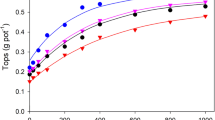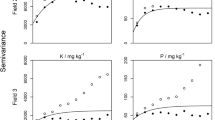Abstract
The effectiveness of a slowly soluble source of phosphate relative to a soluble source may decrease with increasing levels of application. This may cause yields to approach a lower asymptote. Four methods for measuring this effect are compared using field experiments in which a calcined rock phosphate (Calciphos) was compared with superphosphate for growth of subterranean clover. The methods were: subjective estimates using a hand drawn calibration curve; objective estimates using a fitted calibration curve; objective estimates using the fit of separate response curves; and objective estimates from the fit of a common response surface in which relative effectiveness was related to level of application. The role of these four methods differs. The first method, though often informative, is suitable only for an initial inspection of the data. The other three methods may all be useful for analysis but the fourth method was the most general. It gave the most sensitive statistical test and had the further advantage that it was a direct test of the hypothesis. All four methods showed that the relative effectiveness of Calciphos decreased with increasing levels of application.
Similar content being viewed by others
References
AOAC (1975) Official Methods of Analysis. 12th edn. Assoc Off Agric Chem: Washington DC, USA
Barrow NJ (1985) Comparing the effectiveness of fertilizers. Fert Res 8: 85–91
Bolland MDA and Barrow NJ (1988) Effect of level of application on the relative effectiveness of rock phosphate. Fert Res 15: 181–92
Bolland MDA and Bowden JW (1982) Long-term availability of phosphorus from calcined rock phosphate compared with superphosphate. Aust J Agric Res 33: 1061–71
Bolland MDA and Bowden JW (1986) Summary of long-term rock phosphate experiments in south-western Australia. J Aust Inst Agric Sci 52: 227–36
Bolland MDA, Bowden JW, D'Antuono MF and Gilkes RJ (1984) The current and residual value of superphosphate, Christmas Island C-grade ore, and Calciphos as fertilizers for a subterranean clover pasture. Fert Res 5: 335–54
Bolland MDA Gilkes RJ and Allen DG (1988) The residual value of superphosphate and rock phosphate for lateritic soils and its evaluation by three soil phosphate tests. Fert Res 5: 253–80
Bolland MDA Weatherley AJ and Gilkes RJ (1988) Residual effectiveness of superphosphate is greater than that of rock phosphate fertilizers for lateritic soils in south-western Australia. Aust J Exp Agric 28: 83–90
Colwell JD (1963) The estimation of phosphorus fertilizer requirements of wheat in southern New South Wales by soil analysis. Aust J Exp Agric Anim Husb 3: 190–7
Doak BW, Callaher PJ, Evans L and Muller FB (1965) Low temperature calcination of C-grade phosphates from Christmas Island. N Z J Agric Res 8: 15–29
Earle DF and McGowan AA (1979) Evaluation and calibration of an automatic rising plate meter for estimating dry matter yield of pasture. Aust J of Exp Agric and Anim Husb 19: 337–43
Engelstad OP, Jugsujinda A and De Datta SK (1974) Response by flooded rice to phosphate rocks varying in citrate solubility. Soil Sci Amer Proc 38: 524–9
Gilkes RJ and Palmer B (1979) Calcined Christmas Island C-grade rock phosphate fertilisers: Mineralogical properties, reversion and assessment by chemical extraction. Aust J Soil Res 17: 467–81
Hoare J (1980) Phosphate raw materials and fertilisers. II. A case history of marginal raw materials. In Khasawneh FE, Sample EC and Kamprath EJ (ed.) The Role of Phosphorus in Agriculture. pp. 121–8 Madison, Wisc: Amer Soc Agron
Kanabo AK and Gilkes RJ (1988) The effect of the level of phosphate rock application on its dissolution in soil and on bicarbonate-soluble phosphorus. Fert Res 16: 67–85
Khasawneh FE and Doll EC (1978) The use of rock phosphate for direct application to soils. Adv Agron 30: 159–206
Mead R and Pike DJ (1975) A review of response surface methodology from a biometric viewpoint. Biometrics 31: 803–51
Nelder JA and Mead R (1965) A simplex method for function minimisation Comp J 7: 308–13
Northcote KH (1979) A factual key for the recognition of Australian soils. 4th edn. Glenside, South Australia: Rellim Tech Publ
Ozanne PG and Shaw TC (1967) Phosphate sorption by soils as a measure of the phosphate requirement of pasture growth. Aust J Agric Res 18: 601–12
van Burg PFJ (1963) The agricultural evaluation of nitrophosphates with particular reference to the direct and cumulative phosphate effects, and the interaction between water solubility and granule size. The Fert Soc Proc No 75
Yeates JS and Allen DG (1987) Low effectiveness of three rock phosphates as phosphorus fertilizers and liming materials on an acid clay loam. Aust J Agric Res 38: 1033–46
Webster R (1989) Is regression what you really want? Soil Use and Managmnt 5: 47–53
Author information
Authors and Affiliations
Rights and permissions
About this article
Cite this article
Barrow, N.J., Bolland, M.D.A. A comparison of methods for measuring the effect of level of application on the relative effectiveness of two fertilizers. Fertilizer Research 26, 1–10 (1990). https://doi.org/10.1007/BF01048739
Issue Date:
DOI: https://doi.org/10.1007/BF01048739




